National Novel Writing Month
Hi, my name is Kate, and I failed NaNoWriMo. (“Hello, Kate…”) National Novel Writing month and the grassroots movement to inspire people to complete a novel in a month are crazy wonderful for two particular reasons: 1) there’s no judgment (The idea is to complete the word count regardless of the words or sentences or plot or anything), and 2) the organization creates an incredibly supportive community. Really, no one fails ( but I still didn’t make the word count…).
During this novel-writing month, some bloggers are tackling questions about the reasons people try to write novels and the reasons people keep writing novels. Bob Clary, from Webucator, asked these questions:
What were your goals when you started writing?
Where I grew up, the things left unsaid were loud in our house. The people who talked were always older than I was, and they ate up all the air. Writing poetry was a quiet way for me to say the unsaid thing, the thing that needed air. I never wanted to write a novel. Other people in my family wrote novels, not me. When I realized I had a bigger story to tell, when the story burst the shell of my poetry, I sought prose, the type of prose that kept its poetic seed. I found Dangerous Writing inspired by Tom Spanbauer.
What are your goals now?
One novel has slipped into the world, Carry the Sky, published by Forest Avenue Press this year, and I’m working on a novel about the 1950s, Sylvia Plath, and McCarthyism, and the novel I started in NaNoWriMo two years ago about an all-girl African safari also in the 1950s.
What pays the bills now?
For twenty-five years I’ve had the privilege of teaching literature, creative writing, and composition at Clackamas Community College in Oregon. I still do.
Assuming writing doesn’t pay the bills, what motivates you to keep writing?
Three things:
1) The stories are burning holes inside me.
2) I’m writing about issues and people and times I don’t understand. The questions compel me, gnaw at me, keep me awake at night, and by writing about them, I hope to find other questions that disturb me less.
3) Community. I have two writing groups, one for poetry, and one for fiction, and those people encourage, cajole, berate, and badger while at the same time, adore, encourage, and support in ways I never thought I’d be able to bear.
And optionally, what advice would you give young authors hoping to make a career out of writing?
Find out what ravishes you, what sticks to your bones, what repels you. Start writing there. Write because your life depends on the questions you ask, the ways you make pieces of your life fit together. Get a day job so that you can be strong enough to write what has gone unsaid. As Maya Angelou once said, “There is no greater agony than bearing an untold story inside you.”
What Makes the Story Real
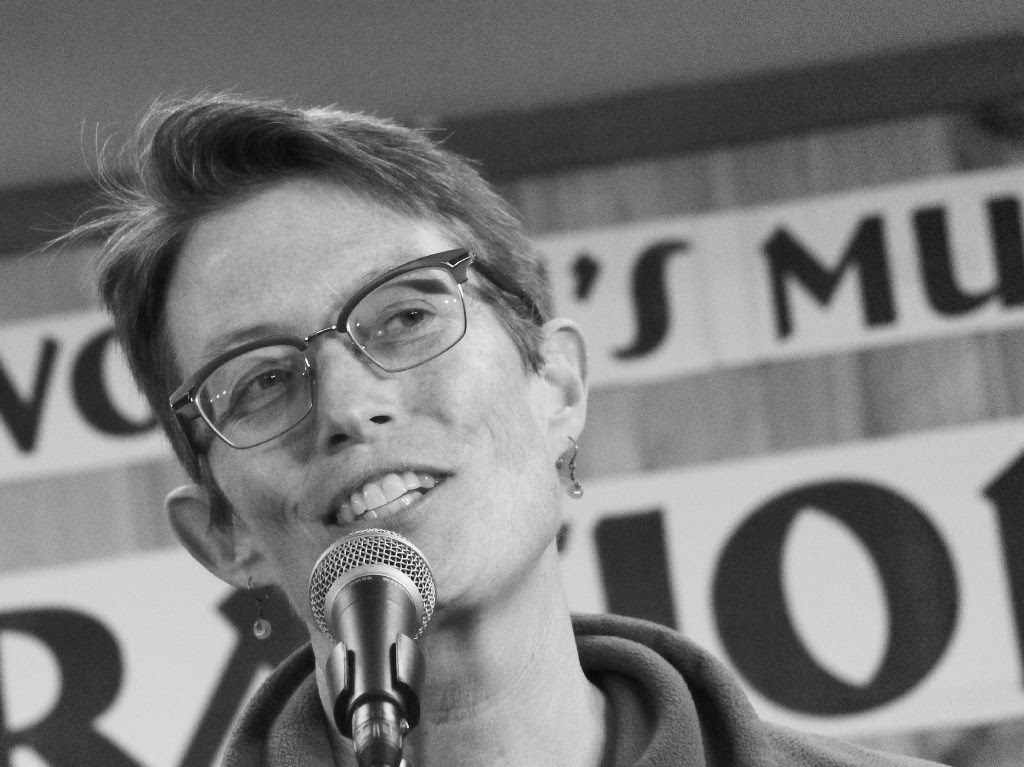 |
| credit: Jean Rosenbaum |
Blog Hop, how cool is this?!
M. Allen Cunningham, the instigator of this blog hop, is the brainchild behind Atelier26, a small-press publisher here in Portland, the author of two novels, The Green Age of Asher Witherow, which was chosen as a Book Sense pick in 2004, and Lost Son, a creative writing handbook, The Honorable Obscurity Handbook, and a collection of short stories, Date of Disappearance. The books Atelier26 publishes are elegant and daring. An upcoming release is a book of poems, entitled Gravity, from Elizabeth Rosner, whose novel, Speed of Light, showed me that a poet’s sound and syntax can create compelling voices in fiction. Her characters tell a story that is heartbreaking, important, and gorgeous. Her book knocked me out, and when I woke up, I was filled with a belief that telling a story in two voices, with a lot of poetry, was possible. Thank you, M. Allen Cunningham, and Elizabeth Rosner.
How this blog hop works is that Mark highlights 3-5 authors, and gives us 7 questions which we are to answer about our novels by a certain deadline. On that day all 3-5 of us post our responses to those 7 questions on our own blogs, and then, we highlight 3-5 more authors, who then have a deadline to respond on their blogs to the same 7 questions. He said it’s like a chain letter but much “less irksome.”
Here are my responses about my forthcoming novel, Carry the Sky, to his 7 questions:
1. What is your character’s name? Is s/he fictional or a historic person?
The story in my novel is told in two voices, and late in the story, a third joins in. All the voices revolve around a central character, a thirteen-year-old boy, named Kyle, who is brilliant, quirky, and troubled. I did not give him a voice in order to accentuate his innocence and to highlight his impact on the other characters. No, the characters are not historical, and yes, they are based on spare parts of real people I have known and bits and pieces of imagination.
2. What should we know about him/her?
All of the characters are recovering from the loss of loved ones. All of the characters are troubled. Do you know any teenagers that aren’t troubled? Even the teachers, the two main speakers, are very young. Taylor Alta is 23, and Jack Song is 28. Everyone means well, even Carla, the senior, who acts impulsively.
3. When and where is the story set?
Welcome back to 1983. Remember the early 80s? “Oh no, Mr. Bill” and Coneheads and Christopher Cross’s song “Sailing,” and Reagan. The setting is a boarding school in Delaware, a place created by the Du Ponts for farm boys to learn the classics and to row. They actually dug a lake long enough for a rowing course. Remember Dead Poets Society? The film was shot at the same boarding school, but unlike the film version, the school was co-ed. I taught in that school for one year. Most people associate boarding schools with New England, and this setting is different because of the overt racism that gently pervades the mid-Atlantic.
4. What are the characters’ personal goals?
Truth is their personal goals get side-swiped (not that they knew their personal goals to begin with). All the characters carry around so much grief and longing that they can’t really make plans or goals. They want to survive, mostly, but they bumble around, hold on to each other for a moment, then lose both the physical and the emotional presence of others who might save them. Where they end up is finding their values. Jack Song articulates more firmly the responsibility he feels as a teacher, a parent for children entrusted to the school while they board, and Taylor Alta realizes that she has to find an environment in which she can live in balance, one that supports her as a lesbian, athlete, and scholar. The one who remains lost is Carla.
5. What is the main conflict? What messes up the characters’ lives?
The main conflict is power and chance. The three speakers are thrown together in the boarding-school world in which class and rank and heterosexuality rule. Their lives are messed up by violence and loss, and that’s before the school year begins.
6. What is this novel’s title, and can we read more about it?
Carry the Sky. You can read about it HERE. The title comes from images in the book and the sense of responsibility teachers feel.
7. When can we expect the book to be published?
Officially it’s due September 1, and I’m honored that Powell’s Books, the mothership of independent bookstores, will host the release party on Friday, Sept. 5th at 7:30pm.
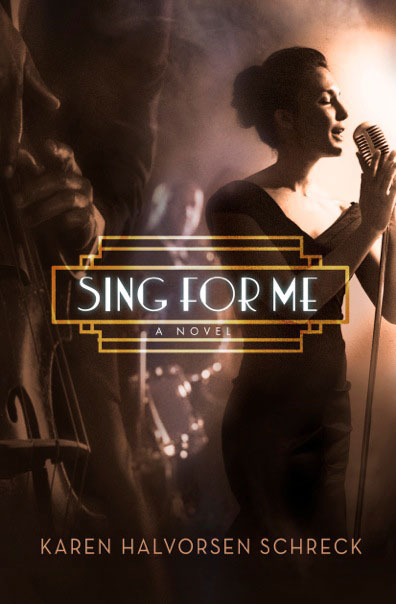 Here are the two writers I get to tag. They will both respond on their blogs to the same 7 questions, by June 28. Presenting the lovely Karen Halvorsen Schreck and Trevor Dodge:
Here are the two writers I get to tag. They will both respond on their blogs to the same 7 questions, by June 28. Presenting the lovely Karen Halvorsen Schreck and Trevor Dodge:
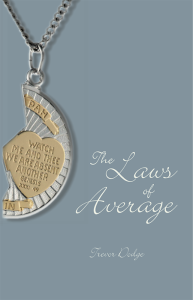 Karen Halvorsen Schreck is a writer who can flex all kinds of muscles. Her latest novel, Sing for Me, is a daring and nuanced look at race, nationality, religion, and art. A young woman who grows up in a prescriptive household dares to follow her passion and sing jazz and ends up saving her family and others. You have to read it. Her previous novel, While He Was Away (2012), is already in its second printing. Her novel Dream Journal was a 2007 Young Adult BookSense Pick. She’s also published an award-winning children’s book, Lucy’s Family Tree.Her short stories and articles have appeared in literary journals and magazines, and have received various awards, including a Pushcart Prize, an Illinois State Arts Council Grant, and in 2008, first prize awards for memoir and devotional magazine writing from the Evangelical Press Association. She lives outside of Chicago with her extraordinary photographer husband and their incredibly talented children.
Karen Halvorsen Schreck is a writer who can flex all kinds of muscles. Her latest novel, Sing for Me, is a daring and nuanced look at race, nationality, religion, and art. A young woman who grows up in a prescriptive household dares to follow her passion and sing jazz and ends up saving her family and others. You have to read it. Her previous novel, While He Was Away (2012), is already in its second printing. Her novel Dream Journal was a 2007 Young Adult BookSense Pick. She’s also published an award-winning children’s book, Lucy’s Family Tree.Her short stories and articles have appeared in literary journals and magazines, and have received various awards, including a Pushcart Prize, an Illinois State Arts Council Grant, and in 2008, first prize awards for memoir and devotional magazine writing from the Evangelical Press Association. She lives outside of Chicago with her extraordinary photographer husband and their incredibly talented children.
Trevor Dodge writes all the time, teaches all the time, and creates opportunities for people to tell their stories in whatever medium best serves them. His latest collection, The Laws of Average, was just released. It’s a collection of 60 flash fiction pieces. I can’t wait to read his responses to the 7 questions. His work has appeared or is forthcoming in journals such as Hobart, Gobshite Quarterly, Metazen, Western Humanities Review, Golden Handcuffs Review, Gargoyle, Notre Dame Review, Natural Bridge and Fiction International. He is the author of another collections of short fiction (Everyone I Know Lives On Roads), a novella (Yellow #10), and is a collaborator (with Lance Olsen) on the writing anti-textbook Architectures of Possibility: After Innovative Writing. And he is an extraordinary friend.
Maya Angelou, RIP
After attending the spring reading for Write Around Portland last night, and hearing the loss to the world of Maya Angelou yesterday, I resurrected an introduction I was honored to write a few years ago to one of Write Around’s earlier anthologies:
Fall is wind and fog, leaf fall and freezing streets, a time when cold can kill, and shelter can beat food and clothing for importance. But for some of us, fall was our salvation; it gave us hours away from watchfulness, freed us from the hyper-vigilance of living in a home that was more dangerous on the inside than on the outside. It brought us pink erasers and picture books, and we could fly to the “second star to the right, and straight on till morning.” Even in Neverland some of us carried sorrow with our schoolbooks, concealed in bags on our backs, or in our bones. That sorrow, alongside the capacity for joy, sometimes came out in song or art or writing. Reading was a stillpoint in commotion.
It was Maya Angelou who saved my life. That sounds trite, but she did. In my high school theater the lights were dim, and a spotlight came on the curtain, stage right, and we heard her voice, that deep-river voice. She started from behind the curtain, “We wear the mask that grins and lies,” and her hand came out and became the mask. “It hides our cheeks and shades our eyes.” And the poem by Paul Laurence Dunbar was nothing I was prepared for. It was blanket and best friend, blood and whistle. It was a toboggan that brought Mari Evans, Robert Hayden, Langston Hughes, Countee Cullen, Frances E.W. Harper crashing into my life, hurtling me across a very cold plain. I wasn’t prepared to let go my loneliness, to slide into an understanding that laughter and song could win out over sorrow and fear, or at least, could be companions.
After reading everything Maya Angelou recited, I was no longer alone. After reading the work in this collection, prepare yourself to no longer be alone. Prepare to read the works of people who have found a stillpoint. The words they write are acts of generosity; they give their stories when stories may be all they have to give; those may be their unmasking. Prepare to recognize yourself as one of the people that Write Around Portland serves, a high school student whose “real never gave up on [him],” a lonely woman who came from a lonely woman, someone who tried over and over to tell herself, “Just don’t kill yourself slowly” and kept killing herself slowly.
Whatever you do, whatever you have to give, prepare. Prepare to be safe.
ARC, how it feels in my hand
I never knew there was so much to publishing a novel. Here’s what I knew:
- You write the sucker.
- You get feedback, and you rewrite it.
- You get rejected, and the comments you get are conflicting, and you rewrite it again.
- You get friends to read it, sometimes out loud (which is a blessing), and you get more rejections when you submit it to contests and publishers, and you take off your leg or arm.
- Once in a blue moon, lightning strikes, and you mix metaphors when your book is accepted because you’re literally ecstatic, out-of-your-body happy.
- And your editor/publisher (Laura, who is a saint) gives you feedback, and if you’re lucky as I am to have an editor who really, really gets your characters and your intention, you dig in and take out and rewrite and tweak the sentences and dialogue.
- And we haven’t even gotten to the copy-editing, yet…
What I didn’t know was:
- putting the manuscript into a style other than MLA style that I have breathed for 25 years of teaching it is like diving under water
- how to punctuate a continuing sentence in dialogue after the attribution…
- Facebook would be key (and really fun and incredibly humbling and awe-inspiring)
- I’d have to buck up and ask people I revere for blurbs and other things (stay tuned)
- people I revere would be so gracious and say yes
- there are a thousand pieces to the cover, like blurbs and fonts and colors and shapes, and the team at Forest Avenue would send 25 emails back and forth in one day about “the” in the title
- other pages I had never thought about like the title page, whether or not to include a table of contents, acknowledgements, epigraph, the bio for the cover, bio for the last page, and more.
- creating a publicity slip
- sending out a publicity slip to a list of people I don’t know and some I do
- ARC (Advanced Reader Copy)
 And here’s what’s amazing: holding that ARC in your hand. Which I can do right now. Uhhhhhhh. Suddenly all these words, started when I woke up in a stinky bedroom that had been a closet in a place affectionately named “The Rat House” in Cannon Beach and scribbled in the dark on a yellow lined pad, have weight. They have a deep purple cover. They have a title that’s different from the one I’ve used for years, and I like this one. It opens up my chest and makes me stand taller. And there’s my name on it, like maybe I have something to do with all these words. And I wonder if I am that person.
And here’s what’s amazing: holding that ARC in your hand. Which I can do right now. Uhhhhhhh. Suddenly all these words, started when I woke up in a stinky bedroom that had been a closet in a place affectionately named “The Rat House” in Cannon Beach and scribbled in the dark on a yellow lined pad, have weight. They have a deep purple cover. They have a title that’s different from the one I’ve used for years, and I like this one. It opens up my chest and makes me stand taller. And there’s my name on it, like maybe I have something to do with all these words. And I wonder if I am that person.
While the process seems glacial, I can barely keep up with all there is to process because it’s moving so fast. The ARC came on Monday. It’s Wednesday, and my eyes are full of tears. I am so grateful.
Not to push the metaphor too far, but this process does feel like riding rollers on my bike. I pedal like mad on the downhill in order to get as much momentum as possible for the uphill. And in this picture, sometimes I glide. And at those times, I say, “Weeeee,” a little like e.e.cummings in “in just-“. “Weeeee” like we’re all in this together….
3 Ways to Regain Your Beginner’s Mind
Last weekend I rode in The Dalles on 8-mile Road without incident. So, what is there to write about you might ask? Plenty.
Learning. Trying things you know you suck at. Remembering how to suspend your terrible self-critic.
Here are three ways I’ve tried lately, three ways that have worked:
1) Drawing with pencil every night before I go to bed, for at least, 100 drawings
Last summer a friend, Hannah, admitted her obsession with Lynda Barry (and what’s not to be obsessed about when it comes to Lynda Barry?). Hannah had taught herself the art of Japanese ink drawing and showed me the gorgeous ritual of preparing the ink, using the stone and brushes and paper and patience to paint every night, to paint 100 demons. Besides the drawings that were fascinating, that Hannah let emerge, saying things like, “I thought I was going to draw X, but this looks more like Y,” and letting Y happen, she would add an active verb. I watched her puzzle the verb out, add the action to the still life. Before me, I saw someone invent, expunge, articulate her demons, or ones that she imagined. Powerful stuff. And so, I took on drawing 100 touches, perhaps because I am not as brave as Hannah, or perhaps because I wanted to sleep without evoking demons.
 Last weekend I completed 100 touches, and I can safely say that I still suck at drawing. But what that experience did was to make me return to the pad every night despite the disdain I had for what I had drawn the night before. It made me see color and light and shadow in my life a completely different way. And every night when I drew something, I spent time breathing deeply, and my sleep was deeper, my dreams more colorful (not scary). I’m scared now, but I’m going to include my last drawing here, anyway.
Last weekend I completed 100 touches, and I can safely say that I still suck at drawing. But what that experience did was to make me return to the pad every night despite the disdain I had for what I had drawn the night before. It made me see color and light and shadow in my life a completely different way. And every night when I drew something, I spent time breathing deeply, and my sleep was deeper, my dreams more colorful (not scary). I’m scared now, but I’m going to include my last drawing here, anyway.
 2) Riding a bike that is better than I am.
2) Riding a bike that is better than I am.
On that bike ride last weekend, I rode my new Optima High Baron, which is a sleek, light, aerodynamic machine. The bike is way more advanced than I am. What I mean is that it responds to my balance, the road conditions, the wind much more quickly than I’m used to. The gears and brakes are different, my body is more reclined, and I have a neck rest because of my body position. If I don’t learn how to relax my shoulders and neck while I ride, I will seriously strain my deltoids and shoulders. The lesson is something I learned in rowing with super elite rowers: when working the hardest, you have to relax on the recovery of the stroke, place your blade in the water exactly when all the others in the eight do, and boom! explode. The boat feels light, and you feel outside of your body, ecstatic. This bike can teach me many things.
3) Responding to a master
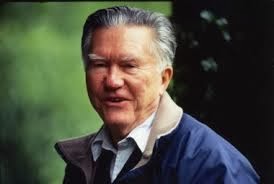 And then there’s William Stafford. We celebrate his birthday every year, but this year, his centennial, the whole state of Oregon is celebrating him. In listening to the celebration by poets at Clackamas, I heard the ways that his poems saved a boy who had wanted to run away from a foster home, how his poems had comforted many in their loneliness, how they had returned alienated people to nature. What I started doing in the mornings, for just 10-15 minutes each morning, is finding one of his poems, retyping it, and responding to it. So far the poems are awful, but that’s okay. I’m writing. I can revise later. I’m starting the day with a poem. The day begins with the blessing of Stafford, and that’s a good day.
And then there’s William Stafford. We celebrate his birthday every year, but this year, his centennial, the whole state of Oregon is celebrating him. In listening to the celebration by poets at Clackamas, I heard the ways that his poems saved a boy who had wanted to run away from a foster home, how his poems had comforted many in their loneliness, how they had returned alienated people to nature. What I started doing in the mornings, for just 10-15 minutes each morning, is finding one of his poems, retyping it, and responding to it. So far the poems are awful, but that’s okay. I’m writing. I can revise later. I’m starting the day with a poem. The day begins with the blessing of Stafford, and that’s a good day.
And the world seems new. Try something you’re not good at. Use a tool that is better than ones you have used before. Take risks.
Note to self
OK, so maybe I should have thought more about it: walking up the .8-mile gravel road with 800 feet elevation gain to then ride on the gravel to the intersection of State Road and Dry Creek, and then to head down the 6-mile hill to Mosier to do a ride which would eventually end in Hood River at a bagel shop to meet a friend for a mid-morning bagel… I didn’t really think about the cold, 24 degrees, or the fog, or how the fog would freeze on the pavement, or how my new bike is so fast and before I know it, goes 40mph, and how wind adds to cold, and before I know it, I can’t feel my feet or hands even though I’m trying to use the brakes and I unclip my shoes and almost drag them in front of me in case I slip on the icy pavement, in case I can keep myself from falling…
I’m not sure why I keep doing these things to myself. Isn’t there a definition of madness I should be wary of…? I kept thinking that the uphills would warm me, that the sun would emerge from the hills and low clouds, that the famous Gorge winds would start up, even a little, and blow the fog away. At Rowena Crest lookout, I noticed my water in my Camelback was frozen. THAT meant cold. No one was there so no one wondered about this 6-foot crazy woman flapping and flailing her arms in a vain attempt to resurrect her fingers… I was too cold to text Cheryl.
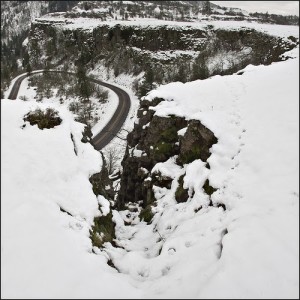 |
| Rowena Crest Loop in snow, not today |
Down the hill I went to scramble to Mosier. Five or six deer stared at me when I stopped again to flail and use centripetal force to get blood to my hands. They stared. They didn’t run. In the grocery store in Mosier the kind shopkeepers let me stand in the doorway and warm myself. The uphill to the twin tunnel trail helped warm me a bit, and I made it to Hood River and the bagel place. But there wasn’t any hot water in the bathroom, Cheryl ordered me a bagel and hot coffee and hot water in a mug, and after 20 minutes I warmed up.
My fingers are swollen as I type this. And from where I sit, I can see Mt. Adams with a lenticular cloud on its top, and sometimes you just have to get out there, no matter how painful. Sometimes you have to start out without thinking of what’s ahead or the dangers or the discomfort. Riding’s like that sometimes.
So’s writing. I don’t know where it will take me or how it will freeze me or make me realize how cold I can be or how kind others can be. Those visceral sensations are part of the journey, part of the risk of throwing your body on the path. You might fail. You might get hurt. And you just might learn something about water and fog and ice and forgiveness.
What we hate but do
My mother hated roses, but she kept them. Red ones. In summer mugginess, she entered the cool garage through the side door, tugged on one green gardening glove, then the other, and with her shears, returned to the roses on their spindly stalks. With thorns the size of baby toes, every time she pruned, she pricked herself bloody. “Cut at the 5,” she said to me on mornings I followed her, the leaf pattern changing down the stalk from 3 to 5. “That’s where they grow.”
My mother would have hated what I’ve published lately, but she would have read it. The poetry and prose I’m writing now feels like cutting roses at the 5-leaf stalks.
The poetry I’m honored to have published in Elohi Gadugi’s special issue on Home(less) try to make people and moments unforgettable. And the prose that I can’t believe is appearing in The Rumpus (All the Longing in the Body) uses a moment in a drive to Pendleton last fall to look at death and disability and love and moments that reveal loyalty and playfulness and devotion.
Lately I’m writing about things that cut us, that make us grow, that show us that the impulse to write comes from the complicated, loving messages we get, and we are obliged to write what even our mothers would hate but would love us for writing.
good news: novel to be published!
This month in Mosier has put my bones back in. The rain on Sunday, the gentle knocking, is the loudest thing on our five acres in the hills overlooking the Gorge. Besides the hollow trill of Warblers. Yesterday I wrote in my journal and read while tending a burn pile to get rid of the “fuel,” the stumps and windfall, that might feed a wildfire during the dry season. And I planted trees. The day before I rode my bike through hillsides covered with Balsam Arrowroot
and Lilacs and goats, and I startled deer, horses, a squirrel rolling in the sand, and a Gray Racer, slithering across the road. And I never felt alone. (Cheryl is away on a training gig.)
Writing can feel lonely sometimes, but for me, the solitude is the key ingredient, the quiet. When I carve out the time to focus on gears shifting on a bike, or word choice, like “mud clotted with rocks in root balls,” not “mud clods and rocks stuck…” in a poem about the burn pile, the space opens in me for connection. That attention to the present allows creativity, gratitude, hope, pain, forgiveness to align like bones.
In that space to create over the past ten years, a story moved through me. At the pinewood table with Stevan Allred and Joanna Rose and so many other brave writers years ago, I walked into fiction. With many different people since then, I’ve connected those words, felt the healing process of writing about the trauma of my first year of teaching, a year in a boarding school in Delaware, that was so difficult it sent me running away from the East Coast, leaving everything behind.
Writing this novel with different groups of people, with readers who were kind and direct, like Hannah Tinti, Minton Sparks, Jackie Shannon-Hollis, Cecily Portman, sending it out to agents and publishers for their comments and rejection, reading it page-by-page to a group of dear friends last summer, rewriting it last fall, obeying Cheryl’s commands to “go write,” has taught me about endurance and faith and luck. Writing fiction for publication is a long-distance event. People make it possible. I’m the one who has to put in the miles, do the hills.
Forest Avenue Press, the brain child of Laura Stanfill, is going to publish that novel, Skin Drag. If ever there were a book written by a community, this is it. So many people helped to write it. While I may have sought solitude to connect words to the page, I was never lonely. And writing it helped me heal the utter loneliness of the real events buried in the fiction.
Thank you, writers, friends, readers, agents, publishers, Laura (you can read her press release here). Thanks for your faith. Skin Drag will be something for your hands to hold in September, 2014.

